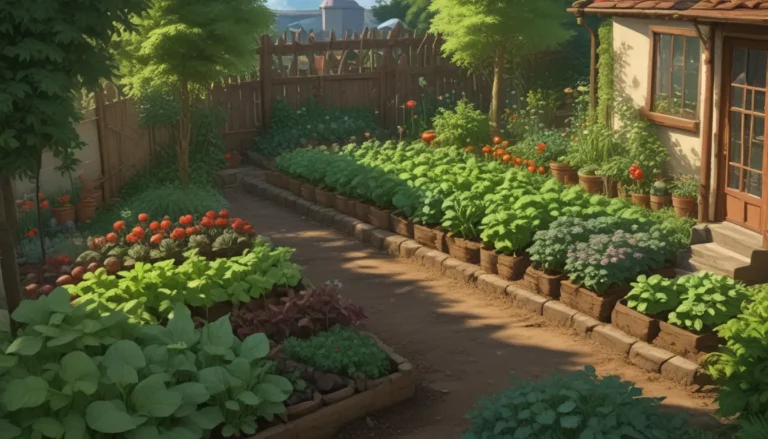Comprehensive Guide to Growing and Caring for Sugar Maple Trees

Are you a fan of pancakes or a lover of maple syrup? If so, the sugar maple tree (Acer saccharum) plays a crucial role in the production of this delightful breakfast condiment. Not only does the sugar maple produce an abundant supply of high-sugar sap perfect for making maple syrup, but it also serves as a stunning addition to any garden or landscape due to its visual and functional qualities.
In this in-depth guide, we will explore everything you need to know about cultivating and caring for sugar maple trees. From propagation methods to the best cultivars to select, to managing pests and disease, this guide covers it all. So let’s dive into the world of sugar maples and discover how you can grow and care for these beautiful trees in your own backyard.
Cultivation and History of Sugar Maple Trees
The sugar maple is native to North America and thrives in USDA Hardiness Zones 4 to 8, making it suitable for a wide range of regions. Known for its recognizable ovate-to-rounded form and distinctive medium green leaves that turn vibrant shades of yellow, orange, and red in the fall, the sugar maple is both visually appealing and culturally significant. The tree’s greenish-yellow flowers and unique bark texture add to its charm, making it a favorite among gardeners and nature enthusiasts alike.
Indigenous Americans have long recognized the value of sugar maples, utilizing them for far more than just their sap. From making sugar and vinegar to using the bark for medicinal purposes and crafting various wooden products, the sugar maple has played an essential role in the lives of early settlers and native populations alike.
Today, sugar maples are not only valued for their sap and wood but also for their ornamental appeal. These versatile trees provide ample shade and aesthetic beauty, making them ideal for a variety of garden settings, including lawns, parks, and public spaces. Additionally, numerous cultivars of A. saccharum have been developed to enhance specific traits, such as sap quality, hardwood characteristics, and ornamental features, offering gardeners a range of options to choose from.
Propagation Methods for Sugar Maple Trees
Sugar maples can be propagated through various methods, each offering gardeners a unique way to multiply their tree collection. From seed propagation to rooting cuttings and layering techniques, there are several options available for those looking to expand their sugar maple population.
From Seed
Growing sugar maple trees from seeds is a feasible option for home gardeners. Harvest the seeds from samaras in the fall and follow a stratification process to prepare them for planting. Once stratified, sow the seeds in a suitable planting medium and provide adequate care until they germinate. Transplant the seedlings into your garden once they are ready for outdoor conditions, ensuring proper spacing and soil quality.
From Cuttings
Taking cuttings from softwood shoots or suckers is another common method of propagating sugar maple trees. Select healthy plant material, treat it with rooting hormone, and plant it in a suitable growing medium to encourage root development. Carefully monitor the cuttings as they grow, preparing them for transplantation once they are established and ready for outdoor conditions.
Via Layering
Layering is another effective propagation technique for sugar maples, with options like mound layering and air layering available to gardeners. By promoting root growth in a controlled environment, gardeners can create new plants from existing specimens, offering a practical and efficient way to expand their tree collection.
Via Transplanting
Transplanting established sugar maple trees or divisions is a straightforward way to propagate new plants. By providing the right conditions and care, gardeners can successfully transplant sugar maples to new locations, ensuring healthy growth and development for the future.
How to Grow Healthy Sugar Maple Trees
To ensure optimal growth and health for your sugar maple trees, it’s essential to provide the right environmental conditions and care. From climate and exposure needs to soil requirements and maintenance tips, here are some essential factors to consider when growing sugar maple trees in your garden:
Climate and Exposure Needs
Sugar maples thrive in USDA Hardiness Zones 4 to 8, with flexible light requirements ranging from full sun to partial shade. While they can tolerate shade, they prefer well-drained, fertile soil that is slightly acidic (pH 5.5 to 6.8). Avoid planting sugar maples in areas with heavy foot traffic or salt exposure, as these conditions can negatively impact their growth and health.
Water and Fertilizer Needs
Sugar maples require consistently moist but well-drained soil to thrive. Avoid overwatering or allowing the soil to become waterlogged, as this can lead to root rot and other issues. Additionally, fertilizing with organic materials like compost or well-rotted manure can provide essential nutrients for healthy growth and development.
Growing Tips for Healthy Sugar Maple Trees
To ensure your sugar maple trees thrive in your garden, consider the following growing tips:
- Provide adequate exposure to light, with full sun to partial shade being ideal.
- Choose planting locations with well-drained, fertile soil that is slightly acidic.
- Maintain consistent moisture levels in the soil without overwatering.
Pruning and Maintenance of Sugar Maple Trees
Pruning sugar maple trees is essential for maintaining their health and appearance. Prune in late winter or early spring to prevent excess sap loss and remove dead or damaged branches. Additionally, mulching around the base of the tree can help regulate soil temperature, conserve moisture, and prevent structural damage, ensuring your sugar maples remain healthy and vibrant.
Best Cultivars to Select for Your Garden
While the standard sugar maple species is a popular choice for many gardeners, several cultivars offer unique traits and characteristics worth considering. Some top cultivars to explore include:
- Autumn Splendor: Known for heat resistance, drought tolerance, and beautiful orange-red foliage.
- Flashfire: Valued for its fiery orange-red fall color and oval-shaped growth habit.
- Legacy: Featuring dense, dark green foliage and yellow-orange fall color, with added drought resistance.
- Oregon Trail: A tough cultivar with tatter-proof leaves and red fall color, suitable for a range of growing conditions.
- Unity: Cold-resistant and heat-tolerant, with beautiful orange-red autumn foliage and impressive growth rate.
Managing Pests and Disease for Healthy Sugar Maple Trees
To protect your sugar maple trees from common pests and diseases, consider implementing proactive measures to keep them healthy and strong. From herbivores like deer, gophers, and rabbits to insect pests like aphids, borers, and scales, there are various challenges to overcome. Likewise, diseases like anthracnose, cankers, and verticillium wilt can pose threats to sugar maple trees if left untreated. By employing integrated pest management practices and monitoring your trees regularly, you can prevent and manage these issues effectively.
Tapping Sap and Processing Maple Syrup
If you’re interested in harvesting maple syrup from your sugar maple trees, the process is relatively straightforward. By tapping the trees at the right time and collecting the sap in suitable containers, you can produce homemade maple syrup with ease. Once collected, boiling the sap and filtering the syrup will result in a delicious and high-quality product ready for consumption or storage. Whether you’re a seasoned syrup maker or a beginner looking to try your hand at this traditional practice, tapping sap from sugar maples is a rewarding and enjoyable experience.
Recipes and Cooking Ideas Using Maple Syrup
For maple syrup enthusiasts, there are several creative and tasty recipes to explore using this versatile ingredient. From breakfast porridge to salads, smoothies, and main dishes, maple syrup adds a unique and delicious flavor to a wide range of culinary creations. Consider trying out some of these recipes to enjoy the natural sweetness and rich taste of maple syrup in your everyday meals.
Quick Reference Growing Guide for Sugar Maple Trees
To help you grow and care for your sugar maple trees effectively, refer to this quick reference guide for essential information on cultivation, maintenance, and use:
- Plant Type: Landscape tree
- Native to: Central and eastern North America
- Hardiness (USDA Zone): 4-8
- Exposure: Full sun to partial shade
- Soil Type: Fertile, moderately moist
- Maintenance: Moderate
- Height: 40-120 feet
- Spread: 30-60 feet
- Best Uses: Maple syrup, shade tree, specimen
- Common Pests and Disease: Aphids, borers, deer, gophers, elk, mice, moose, rabbits, scale; anthracnose, cankers, leaf spot, tar spot, verticillium wilt
Conclusion: The Sweet Rewards of Growing Sugar Maple Trees
In conclusion, sugar maple trees are a valuable addition to any garden or landscape, offering beauty, functionality, and the potential for homemade maple syrup. By following the guidelines and tips outlined in this comprehensive guide, you can grow and care for healthy sugar maple trees in your own backyard. From propagation methods to cultivation techniques, pruning tips, and syrup production, there is much to learn and enjoy in the world of sugar maples. So why not give it a try and plant a few sugar maple trees in your garden today?
We hope you found this guide informative and helpful for your gardening endeavors. If you have any questions or comments, feel free to share them below. Happy gardening!





